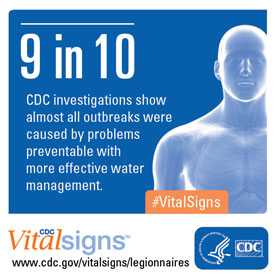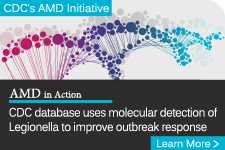Outbreaks

Legionellosis outbreaks occur when two or more people are exposed to Legionella and get sick in the same place at about the same time. People can get legionellosis when they breathe in a mist (small droplets of water in the air) that is contaminated with Legionella.
Outbreaks are commonly associated with buildings or structures that have complex water systems, like hotels and resorts, long-term care facilities, hospitals, and cruise ships. The most likely sources of infection include water used for showering, hot tubs, decorative fountains and cooling towers (parts of centralized air-conditioning systems for large buildings).
Legionellosis outbreaks can be difficult to identify, especially if people travel to a common location, are exposed to Legionella, and then return home before becoming sick. State and local health departments take the lead in investigating outbreaks and implementing control measures to remove Legionella from the water identified as the source of infection. CDC is only involved in legionellosis outbreak investigations when additional assistance is requested. State and local health departments are the best source of information for a specific outbreak.
Top of PageOutbreak Articles and Publications
- Quinn C, Demirjian A, Lucas C, et al. Legionnaires’ disease outbreak at a long-term care facility caused by a cooling tower using an automated disinfection system—Ohio, 2013 [6 pages]. J Environ Health. 2015;78(5):8–13.
- Beer KD, Gargano JW, Roberts VA, et al. Outbreaks associated with environmental and undetermined water exposures — United States, 2011–2012. MMWR Morb Mortal Wkly Rep. 2015;64(31):849–51.
- Beer KD, Gargano JW, Roberts VA, et al. Surveillance for waterborne disease outbreaks associated with drinking water — United States, 2011–2012. MMWR Morb Mortal Wkly Rep. 2015;64(31):842–8.
- Demirjian A, Lucas CE, Garrison LE, et al. The importance of clinical surveillance in detecting Legionnaires' disease outbreaks: A large outbreak in a hospital with a Legionella disinfection system—Pennsylvania, 2011–2012. Clin Infect Dis. 2015;60(11):1596–1602.
- CDC. Recreational water-associated disease outbreaks—United States, 2009-2010. MMWR Morb Mortal Wkly Rep 2014;63:6–10.
- Silk BJ, Moore MR, Bergtholdt M, et al. Eight years of Legionnaires' disease transmission in travellers to a condominium complex in Las Vegas, Nevada. Epidemiol Infect. 2012;140:1993–2002.
- Benin AL, Benson RF, Arnold KE, et al. An outbreak of travel-associated Legionnaires’ disease and Pontiac fever: the need for enhanced surveillance of travel-associated legionellosis. J Infect Dis. 2002;185:237–43.
- Kool JL, Fiore AE, Kioski CM, et al. More than 10 years of unrecognized nosocomial transmission of Legionnaires’ disease among transplant patients. Infect Ctrl and Hosp Epi 1998;19:898–904.
- Lepine LA, Jernigan DB, Butler JC, et al. A recurrent outbreak of nosocomial Legionnaires’ disease detected by urinary antigen testing: evidence for long-term colonization of a hospital plumbing system. Infect Ctrl and Hosp Epi. 1998;19:905–10.
Related Links
- Page last reviewed: May 31, 2016
- Page last updated: June 7, 2016
- Content source:



 ShareCompartir
ShareCompartir